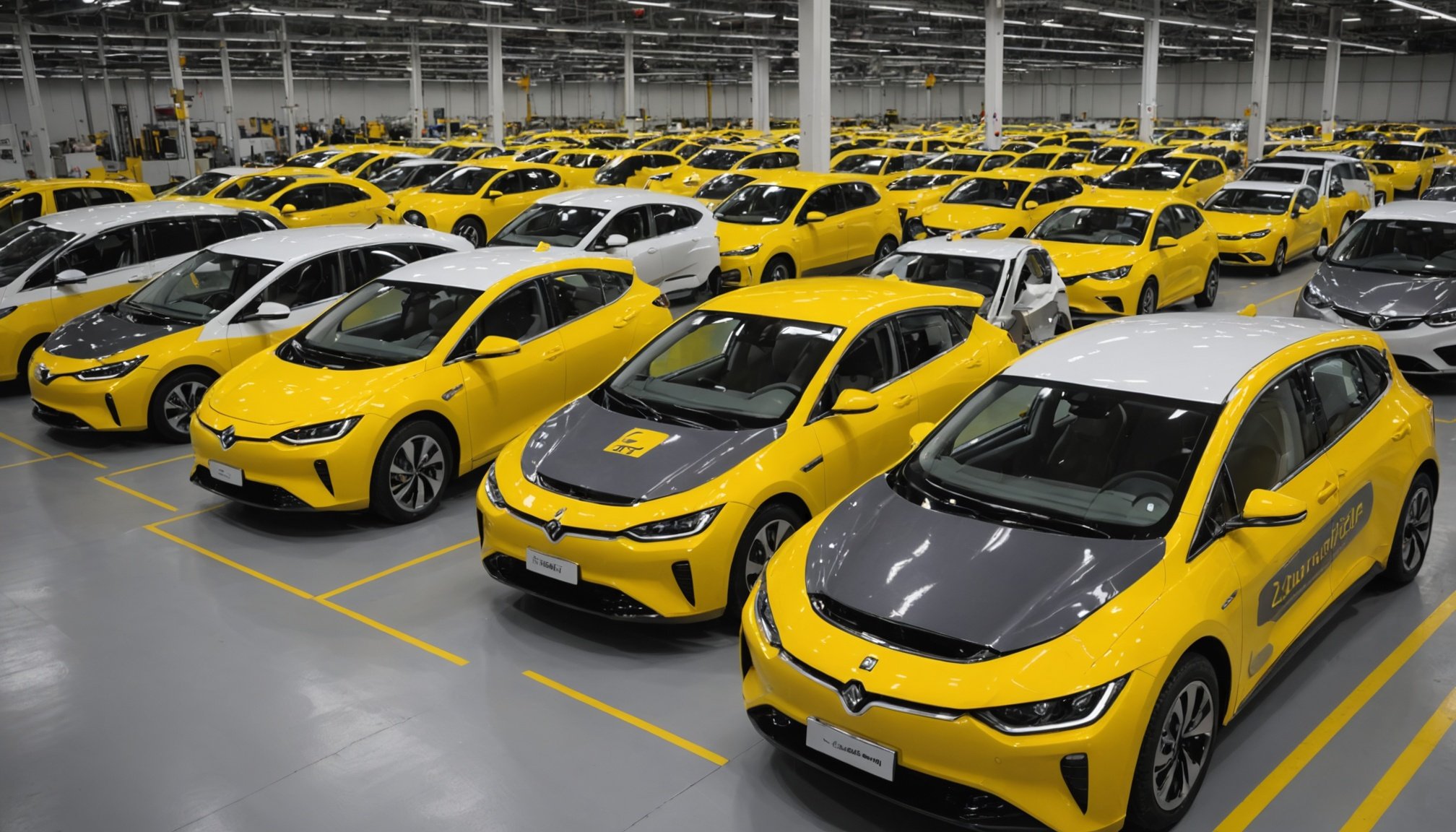Unleashing the Future: Groundbreaking Lithium-Sulfur Battery Innovations Transforming Electric Vehicles
As the world continues to transition towards more sustainable energy sources, the development of advanced battery technologies has become a critical component in this journey. Among the various innovations in the battery sector, lithium-sulfur batteries are emerging as a promising solution, particularly for electric vehicles. Here, we delve into the details of these groundbreaking batteries and how they are set to transform the electric vehicle industry.
The Current State of Lithium-Ion Batteries
Before diving into lithium-sulfur batteries, it’s essential to understand the current landscape of lithium-ion batteries, which have been the cornerstone of electric vehicles for years.
In the same genre : Transforming industrial automation: essential innovations in sensor technology you must explore
Lithium-ion batteries have several advantages, including high energy density, long cycle life, and relatively low self-discharge rates. However, they also come with some significant limitations. For instance, lithium-ion batteries face challenges related to charging times, safety concerns such as thermal runaway, and environmental impacts associated with lithium extraction and battery disposal[4].
The Promise of Lithium-Sulfur Batteries
Lithium-sulfur batteries are being hailed as the next generation of battery technology, offering several potential advantages over traditional lithium-ion batteries.
Have you seen this : Transforming urban rush hour: the game-changing impact of ai on traffic control
Higher Energy Density
One of the most significant benefits of lithium-sulfur batteries is their potential to achieve higher energy densities. According to Robin Zeng, the CEO of CATL, these batteries could reach an energy density of 500 Wh/kg, which is a more than 40% improvement over current lithium-ion batteries. This increased energy density means that electric vehicles could travel farther on a single charge, making them more practical for long-distance travel[1].
Improved Safety and Performance
Lithium-sulfur batteries also promise improved safety and performance. Unlike lithium-ion batteries, which can be prone to thermal runaway and other safety issues, lithium-sulfur batteries are designed to be more stable and secure. For example, Solidion Technology has developed a graphene-based heat spreader system that efficiently manages battery temperature during charging and operation, addressing key safety concerns[2].
Sustainable Materials and Production
The use of sulfur in these batteries is also more environmentally friendly compared to some of the materials used in lithium-ion batteries. Sulfur is abundant and can be sourced from various industrial by-products, reducing the environmental impact associated with mining and processing rare earth metals. Additionally, the production process for lithium-sulfur batteries is being optimized to be more sustainable, with a focus on reducing waste and minimizing environmental footprint[3].
Overcoming the Challenges
While lithium-sulfur batteries hold great promise, there are several challenges that need to be overcome before they can be widely adopted.
Design, Manufacturing, and Equipment Issues
Robin Zeng of CATL highlighted that European battery manufacturers often face issues related to poor cell design, inadequate manufacturing processes, and suboptimal equipment. These issues can lead to problems with battery usage, reliability, and safety over time. For instance, if the design and manufacturing are not optimized, the batteries may function well at a small scale but fail to deliver consistent quality and reliability in mass production[1].
Charging Times and Cycle Life
Another significant challenge is the improvement of charging times and cycle life. Solidion Technology’s innovation with a graphene-based heat spreader system is a step in the right direction, enabling 5-minute charging times. However, even with such advancements, there are still issues related to the cycle life and durability of lithium-sulfur batteries that need to be addressed. Researchers are working on optimizing the chemistry and implementing advanced charging algorithms to enhance these aspects[2].
Key Innovations and Developments
Several key innovations and developments are driving the progress of lithium-sulfur batteries.
CATL’s Solid-State Battery Technology
CATL is at the forefront of solid-state battery technology, including lithium-sulfur batteries. With a team of over 20,000 engineers focused on R&D, CATL is investing heavily in the development of solid-state batteries. Their recent focus on sulfur-based solid-state batteries aims to achieve higher energy densities and improved safety. For example, CATL has entered a trial production phase for 20 Ah samples, which is a significant step towards commercialization[1].
Solidion’s Graphene-Based Technology
Solidion Technology’s graphene-based heat spreader system is another groundbreaking innovation. This system alternates between heating during charging and cooling during discharge, utilizing graphene’s superior thermal conductivity. This technology not only enables fast charging in all weather conditions but also addresses the limitations of current EV batteries in cold temperatures[2].
Applications and Future Potential
Lithium-sulfur batteries have a wide range of applications beyond electric vehicles.
Electric Vehicles
The primary application of lithium-sulfur batteries is in electric vehicles, where they promise to extend the range, improve safety, and reduce charging times. With higher energy densities and faster charging capabilities, these batteries could make electric vehicles more appealing to a broader audience.
Renewable Energy Storage
Lithium-sulfur batteries can also play a crucial role in renewable energy storage. By storing excess energy generated from solar or wind power, these batteries can help stabilize the grid and support the integration of renewable energy sources. This application is particularly important as the world transitions towards more sustainable energy sources[3].
Comparative Analysis: Lithium-Ion vs. Lithium-Sulfur Batteries
Here is a comparative analysis of lithium-ion and lithium-sulfur batteries based on several key parameters:
| Parameter | Lithium-Ion Batteries | Lithium-Sulfur Batteries |
|---|---|---|
| Energy Density | Up to 250 Wh/kg | Potential to reach 500 Wh/kg |
| Charging Times | Several hours | As low as 5 minutes with graphene-based systems |
| Safety | Prone to thermal runaway | More stable and secure due to sulfur chemistry |
| Materials | Lithium, cobalt, nickel | Lithium, sulfur (more abundant and environmentally friendly) |
| Cycle Life | Up to 10,000 cycles | Still in development, but potential for longer cycle life |
| Environmental Impact | Significant mining and processing impacts | More sustainable materials and production processes |
| Cost | High due to rare earth metals | Potentially lower due to abundant sulfur |
Practical Insights and Actionable Advice
For those interested in the future of electric vehicles and energy storage, here are some practical insights and actionable advice:
- Stay Informed: Keep up with the latest developments in battery technology. Innovations like those from CATL and Solidion Technology are regularly announced, and staying informed can help you make better decisions.
- Invest in Sustainable Technologies: As the world moves towards more sustainable energy sources, investing in companies that are at the forefront of these technologies can be beneficial.
- Consider Long-Term Benefits: When evaluating battery technologies, consider the long-term benefits such as higher energy densities, faster charging times, and improved safety.
- Support Research and Development: Encourage and support research in battery technologies. This can be through funding initiatives, participating in pilot programs, or advocating for policies that support sustainable energy research.
Quotes from Industry Leaders
Here are some quotes from industry leaders that highlight the significance and potential of lithium-sulfur batteries:
- “They have a bad design, a bad manufacturing process, and bad equipment. If they scale up, they will encounter usage problems, then reliability problems, and 2 or 3 years later, they will have safety problems. So almost all the mistakes at the same time.” – Robin Zeng, CEO of CATL[1].
- “Our graphene-based heat spreader system efficiently manages battery temperature during charging and operation, addressing key challenges in EV adoption.” – Solidion Technology[2].
Lithium-sulfur batteries represent a significant leap forward in battery technology, offering higher energy densities, improved safety, and faster charging times. As the world continues to transition towards sustainable energy sources, these batteries are poised to play a crucial role in transforming electric vehicles and energy storage solutions.
While there are challenges to overcome, the innovations from companies like CATL and Solidion Technology are paving the way for a future where electric vehicles are more practical, sustainable, and powerful. As we move forward, it is essential to stay informed, support research and development, and consider the long-term benefits of these technologies.
In the words of Robin Zeng, “The evolution of batteries is fascinating, like many other themes related to electric mobility.” Indeed, the future of lithium-sulfur batteries is bright, and it holds the key to unlocking a more sustainable and energy-efficient world.











